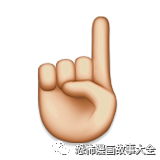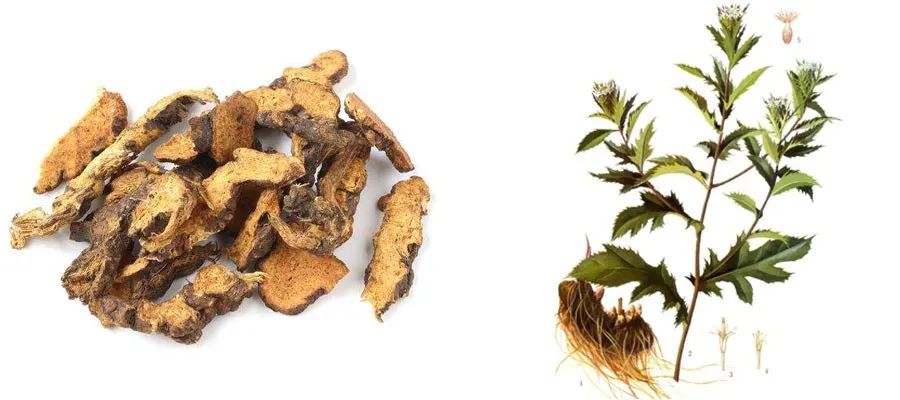 Click on 【Herb Query】, then click the upper right corner 【···】
Click on 【Herb Query】, then click the upper right corner 【···】
Set as Star/Top
Star/Top for easy access
for easy access
Cang Zhu

【Medicinal Source】 is the dried rhizome of the Asteraceae plant, Atractylodes.
【Properties】 Nature: warm, Taste: pungent, bitter.
【Meridians】 Enters the Spleen, Stomach, and Liver meridians.
【Functions】 Dries dampness, strengthens the spleen, dispels wind, and alleviates cold, brightens the eyes.
Cang Zhu belongs to the Asteraceae family, mainly divided into southern Cang Zhu and northern Cang Zhu, both growing in drier mountainous areas. Southern Cang Zhu is solid, with a flat break surface, yellowish-white, and has distinct reddish-brown oil glands scattered, commonly referred to as “vermilion dots”. When cut, it emits a fragrant aroma, and if the break surface soon develops a white frost, it is considered the best quality, primarily produced in Jiangsu and Henan, with the best quality from the Maoshan area in Jiangsu, hence called “Maoshu” or “Maoshan Cang Zhu”. In the past, the distribution center for southern Cang Zhu was in Nanjing, also known as “Jing Cang Zhu” or “Jing Maoshu”.
Northern Cang Zhu is mainly produced in North China and is of inferior quality compared to southern Cang Zhu. Cang Zhu can be wild or cultivated, often growing spontaneously in mountain villages and fields. Historically, there were about four provinces for cultivated Cang Zhu, namely Sichuan, Guangxi, Guizhou, and Fujian, with Guangxi being the best quality, followed by Guizhou and Fujian, and Sichuan being the least.
1. Li Shizhen and Cang Zhu
Ancient texts say: Cang Zhu is the essence of the mountain, consuming it can help one avoid hunger and achieve longevity, hence the elegant titles of mountain essence, immortal technique, and heavenly essence. The character for Zhu, according to the Six Scripts, originally depicted its root and branches, hence the name. In the Japanese text “Wakan Yaku Kō”, it is also referred to as “Maoshu’s treasure box”.
The Cang Zhu produced in Jiangsu Maoshan has a unique fragrance, and when cut, it reveals seven vermilion dots that remain unchanged over time. Both “Bencao Gangmu” and “Jintan County Annals” record: “Cang Zhu is produced in the Shimen area of Maoshan, and those with vermilion dots when cut are rare treasures.”
It is said that during the Ming Dynasty, the great pharmacologist Li Shizhen collected medicinal materials in Maoshan and discovered a tall and large Cang Zhu growing on a cliff, with an extraordinary fragrance. What was even more remarkable was that this Cang Zhu grew on a piece of crane beak stone, jutting out from the mountain rock, resembling a crane with a white neck, gray feathers, and a red crown. Li Shizhen carefully approached the rock and used a medicinal hoe to dig up this extraordinary herb. After several digs, a small stone was dislodged and landed perfectly on the crane’s red crown, causing seven drops of blood to drip down. Li Shizhen was quite astonished, and with a loud bang, the rock transformed into a beautiful crane, which let out three long cries and soared into the clouds. Upon examining the Cang Zhu, he found seven bright red vermilion dots inside.
From then on, the vermilion dots of Maoshan Cang Zhu never faded, and its efficacy far surpassed that of Cang Zhu from other regions.
2. “To Achieve Longevity, Regularly Consume Mountain Essence”
Cang Zhu is an ancient Chinese medicinal herb, mentioned in the “Shennong Bencao Jing”: “Cang Zhu, when prepared as a decoction, if taken for a long time, can lighten the body and prolong life.” The Jin Dynasty health scholar Ge Hong recorded in his book “Baopuzi”: “During the end of the Han Dynasty, a man named Wen from Nanyang escaped to Mount Hua, starving and on the verge of death. Someone taught him to eat Cang Zhu, and he was no longer hungry. After several decades, he returned to his hometown, looking younger and feeling lighter, hence Cang Zhu is called mountain essence, as Shennong’s medicinal text states that to achieve longevity, one must regularly consume mountain essence.”
In ancient medical prescriptions, Cang Zhu was often used as a remedy for longevity, such as in the “Deng Cai Bifeng Zahui Fang” which mentions “Cang Zhu paste”, claiming it “strengthens the spleen and stomach, enhances complexion, and has significant effects on replenishing deficiencies.” In the “Liu Songshi Baoshoutang Fang”, the “Shaoyang Dan” uses one pound of processed Cang Zhu, twenty pounds of ripe mulberries, mixed into a paste, dried, and formed into honey pills the size of red beans, to be taken with wine three times a day. “In one year, white hair turns black, and in three years, the face appears youthful.” Another example is the “Ruizhutang Fang”‘s “Guzhen Dan”, which dries dampness and nourishes the spleen, assisting the stomach to solidify the essence, using one pound of Maoshan Cang Zhu divided into four parts, with each part stir-fried with different ingredients, and then ground into powder, mixed with wine to form pills. This combination uses Cang Zhu as the main ingredient to nourish the spleen and assist the stomach, enhancing the source of postnatal essence, and is particularly suitable for those with weak spleen function.
In ancient times, the famous physician Huangfu Mi had a recipe called the “Elixir of Immortality”, which also used Cang Zhu as the main herb, prepared in various ways with wine, vinegar, salt, and pepper, combined with black beans and red dates, steamed until soft, dried, and ground into pills. The original text states: “Taking it for seven days will not result in white hair.” TCM experts believe that this method of using herbs aligns with the principles of “Suxiang, Zangqi Fa Shilun” which states, “When the flavors are combined, they can replenish and benefit the essence.” To this day, the efficacy of Cang Zhu in “lightening the body and prolonging life” still warrants further research.
3. Cang Zhu and Bai Zhu
In the “Shennong Bencao Jing”, there is no distinction between Cang Zhu and Bai Zhu. The Eastern Han physician Zhang Zhongjing used Bai Zhu in “Shanghan Lun”, while in “Jinkui”, he first used Chi Zhu, which is Cang Zhu. Therefore, the distinction between Cang Zhu and Bai Zhu likely began with the sage of TCM, Zhang Zhongjing. Although Cang Zhu and Bai Zhu belong to the same species and share the same name, historical physicians have still made distinctions in their applications. As the Qing Dynasty physician Zhang Yinan stated: “Bai Zhu is superior in nature, while Cang Zhu is inferior. If one wishes to tonify the spleen, Bai Zhu should be used; if one wishes to move the spleen, Cang Zhu should be used. If both tonification and movement are needed, they should be used together, with more Bai Zhu and less Cang Zhu for tonifying more and moving less, and vice versa.”
Both Cang Zhu and Bai Zhu can strengthen the spleen and dry dampness, but Cang Zhu is superior in its ability to dry and dispel dampness, while Bai Zhu is better at tonifying the spleen with a sweet and moistening effect. Cang Zhu can raise yang and relieve depression, while Bai Zhu can tonify qi and generate blood. Cang Zhu is pungent and strong in drying dampness, while Bai Zhu is sweet and moistening, with more tonifying effects. For example, the renowned TCM physician Wei Longxiang was known for using high doses of Bai Zhu to treat elderly patients with qi deficiency and constipation, often exceeding 60 grams, achieving excellent results. This reminds one of a poem by Shao Bao from the Song Dynasty: “The physician values Bai Zhu from Tiantai, Shao Shou once brought honeyed treats. After chewing, the fragrance fills the room, and the peach blossom stream dreams of the Yao Tai.” This poem expresses gratitude for a friend’s gift of Bai Zhu, indicating that the Bai Zhu from Tiantai Mountain is a genuine medicinal material, and after being soaked in honey, it fills the room with fragrance and brings comfort. This suggests that honey-soaked Bai Zhu is particularly beneficial for the elderly with weakness and constipation, as it can utilize Bai Zhu’s tonifying and laxative properties, aided by honey’s moistening effects. In summary, Cang Zhu is strong in drying, effective in dispelling dampness, while Bai Zhu excels in tonifying and benefiting qi. The ancients stated, “For soil that is deficient, Bai Zhu should be used to nourish it; for soil that is excessive, Cang Zhu should be used to balance it.” This principle is based on the five elements, where insufficient earth should be supplemented with Bai Zhu, while excessive earth, leading to spleen dampness, should be treated with Cang Zhu to move the spleen. This is one of the differences in their applications.
Modern physician Zhang Shanlei believes that the main treatment of Cang Zhu is for wind, cold, and dampness, while Cang Zhu’s fragrance is particularly strong, effective in dispelling wind and dampness; Bai Zhu is more balanced, primarily focusing on tonifying the spleen. Therefore, Cang Zhu is often used to treat bi syndrome, which is another difference in their applications.
In ancient medical prescriptions, Cang Zhu was often used to improve vision and treat conditions such as night blindness, blurred vision, and eye fatigue, while Bai Zhu was not used for such purposes. For example, the “Shenghui Fang” uses processed Cang Zhu powder, mixed with pig or lamb liver, to treat eye fatigue. Alternatively, Cang Zhu can be mixed with other herbs and taken to treat blurred vision. The “Youyou Xinshu” also mentions using Cang Zhu powder mixed with pig bile to treat infants’ eye fatigue. Bai Zhu has not been noted for its efficacy in improving vision, and modern research has confirmed that this is due to Cang Zhu’s rich vitamin A content, which can treat vitamin A deficiency-related night blindness and corneal softening. This is another difference in their applications.
In China, there is a traditional custom of purchasing Cang Zhu and Bai Zhi on the Dragon Boat Festival, burning them indoors to ward off epidemics and drive away evil spirits. This practice is observed regardless of wealth, becoming an unbreakable tradition. This is because “Cang Zhu’s aroma is strong, more so than Bai Zhu, capable of penetrating deeply and dispelling foul odors, overcoming the unwholesome qi of the four seasons.” Zhang Shanlei also agrees, stating that “Cang Zhu is often used to drive away foul and turbid qi, especially in damp and dark environments.” According to the “Shuinan Hanji”, it is recorded that “Fan Wenzheng’s residence must first clear the well, adding several pounds of Cang Zhu to dispel pestilential qi.” Modern experiments have shown that burning Cang Zhu and Ai Ye can purify indoor air and has a killing effect on various bacteria, which is another use that Bai Zhu does not possess.
End of Article. Thank you for your patience in reading. If you find it interesting, please click “

